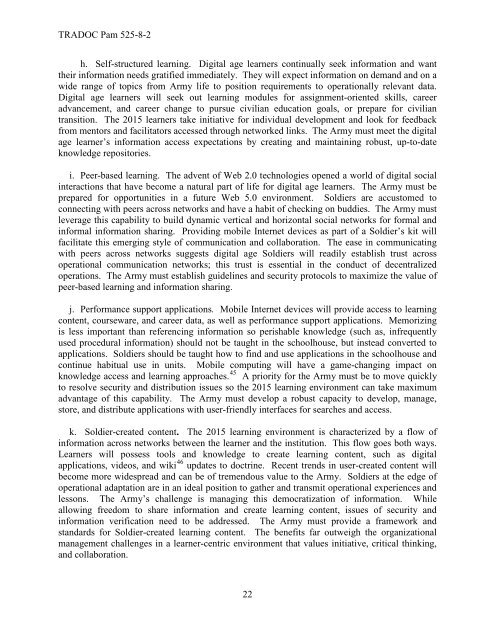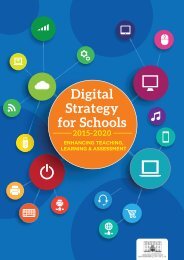K3zgZ
K3zgZ
K3zgZ
Create successful ePaper yourself
Turn your PDF publications into a flip-book with our unique Google optimized e-Paper software.
TRADOC Pam 525-8-2<br />
h. Self-structured learning. Digital age learners continually seek information and want<br />
their information needs gratified immediately. They will expect information on demand and on a<br />
wide range of topics from Army life to position requirements to operationally relevant data.<br />
Digital age learners will seek out learning modules for assignment-oriented skills, career<br />
advancement, and career change to pursue civilian education goals, or prepare for civilian<br />
transition. The 2015 learners take initiative for individual development and look for feedback<br />
from mentors and facilitators accessed through networked links. The Army must meet the digital<br />
age learner’s information access expectations by creating and maintaining robust, up-to-date<br />
knowledge repositories.<br />
i. Peer-based learning. The advent of Web 2.0 technologies opened a world of digital social<br />
interactions that have become a natural part of life for digital age learners. The Army must be<br />
prepared for opportunities in a future Web 5.0 environment. Soldiers are accustomed to<br />
connecting with peers across networks and have a habit of checking on buddies. The Army must<br />
leverage this capability to build dynamic vertical and horizontal social networks for formal and<br />
informal information sharing. Providing mobile Internet devices as part of a Soldier’s kit will<br />
facilitate this emerging style of communication and collaboration. The ease in communicating<br />
with peers across networks suggests digital age Soldiers will readily establish trust across<br />
operational communication networks; this trust is essential in the conduct of decentralized<br />
operations. The Army must establish guidelines and security protocols to maximize the value of<br />
peer-based learning and information sharing.<br />
j. Performance support applications. Mobile Internet devices will provide access to learning<br />
content, courseware, and career data, as well as performance support applications. Memorizing<br />
is less important than referencing information so perishable knowledge (such as, infrequently<br />
used procedural information) should not be taught in the schoolhouse, but instead converted to<br />
applications. Soldiers should be taught how to find and use applications in the schoolhouse and<br />
continue habitual use in units. Mobile computing will have a game-changing impact on<br />
knowledge access and learning approaches. 45 A priority for the Army must be to move quickly<br />
to resolve security and distribution issues so the 2015 learning environment can take maximum<br />
advantage of this capability. The Army must develop a robust capacity to develop, manage,<br />
store, and distribute applications with user-friendly interfaces for searches and access.<br />
k. Soldier-created content. The 2015 learning environment is characterized by a flow of<br />
information across networks between the learner and the institution. This flow goes both ways.<br />
Learners will possess tools and knowledge to create learning content, such as digital<br />
applications, videos, and wiki 46 updates to doctrine. Recent trends in user-created content will<br />
become more widespread and can be of tremendous value to the Army. Soldiers at the edge of<br />
operational adaptation are in an ideal position to gather and transmit operational experiences and<br />
lessons. The Army’s challenge is managing this democratization of information. While<br />
allowing freedom to share information and create learning content, issues of security and<br />
information verification need to be addressed. The Army must provide a framework and<br />
standards for Soldier-created learning content. The benefits far outweigh the organizational<br />
management challenges in a learner-centric environment that values initiative, critical thinking,<br />
and collaboration.<br />
22




